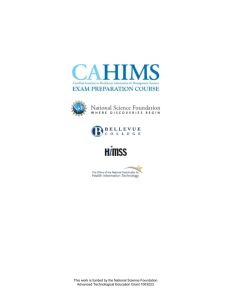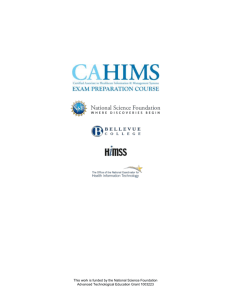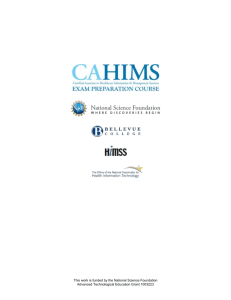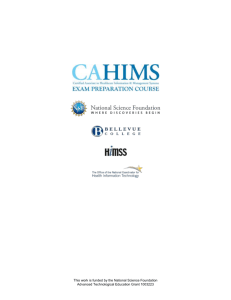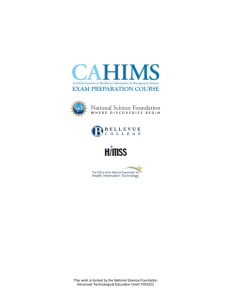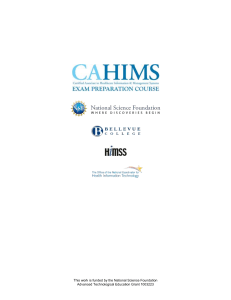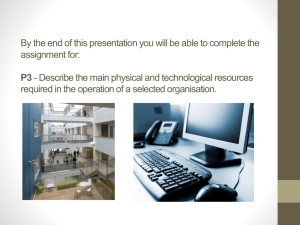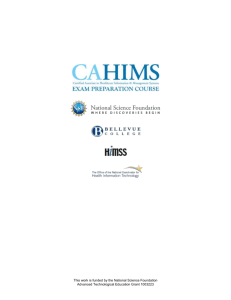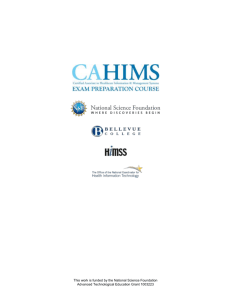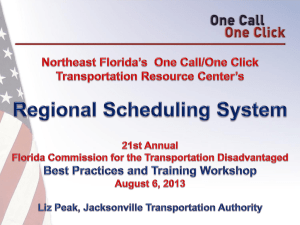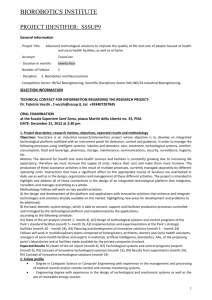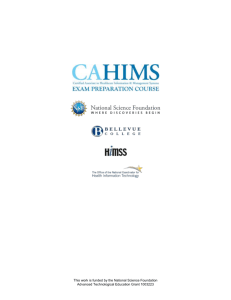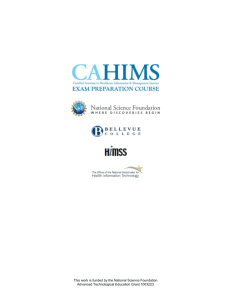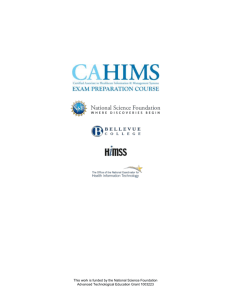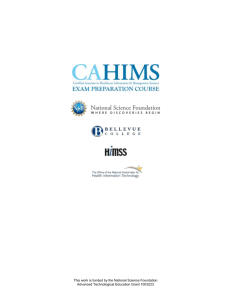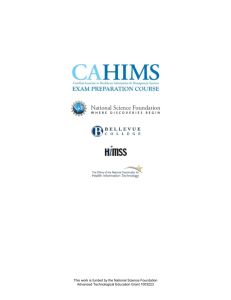2.5-Assessment-Key
advertisement
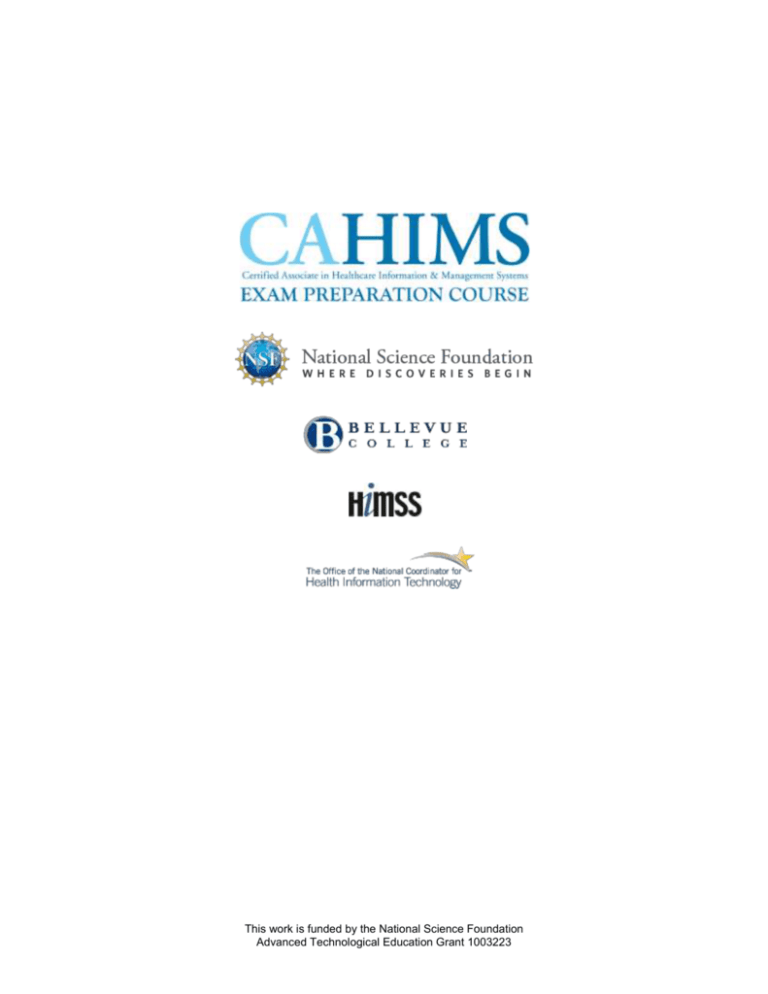
This work is funded by the National Science Foundation Advanced Technological Education Grant 1003223 The CAHIMS Exam Preparation Course and the CAHIMS exam are the result of collaboration between the Life Science Informatics Center at Bellevue College and the Healthcare Information and Management Systems Society (HIMSS). Significant content found in the CAHIMS Exam Preparation Course stems from the Office of the National Coordinator for Health Information Technology. Creation of the CAHIMS Exam Preparation Course and the CAHIMS exam was made possible through support from the National Science Foundation (NSF). Curriculum Team: Margaret Schulte, DBA Michèle Royer, PhD Nathan Savage, MLIS This work is funded by the National Science Foundation Advanced Technological Education Grant 1003223 Section 2 - Technology Environment Lesson 2.5 - Systems Architecture and Components Assessment Questions Answer Key Lectures 1, 2 & 3 1. The motherboard is made up of circuitry and thousands of copper wires known as __________. a. binary code b. RAM *c. buses d. chips Answer: c. Lecture(s)/Slide(s): 1/6 2. The CPU improves its performance through the implementation of one or more __________, which is made up of one or more __________. a. CPUs, fetches *b. processes, threads c. cores, execute operations d. states, tasks Answer: b. Lecture(s)/Slide(s): 3/15 3. A(n) __________ jack is used to connect a network cable to a network interface card. a. RJ-11 b. 802.11N *c. RJ-45 d. Either A or C Answer: c. Lecture(s)/Slide(s): 2/8 This work is funded by the National Science Foundation Advanced Technological Education Grant 1003223 Page 1 4. Hard disk storage is known as __________ storage. *a. secondary b. volatile c. RAM d. primary Answer: a. Lecture(s)/Slide(s): 2/13 5. The operating system is stored __________. a. in RAM when the computer is running b. on the hard disk *c. Either A or B d. None of the above Answer: c. Lecture(s)/Slide(s): 2/12, 13 6. What is a CT scan? a. A nuclear medicine imaging device that produces a 3-D image. b. A device that creates an image based on sound waves. *c. An x-ray, using specialized equipment, that takes cross-sectional pictures of the body. d. Magnetic imaging equipment that uses a radio frequency pulse to create an image. Answer: c. Lecture(s)/Slide(s): 1/17 7. What is an MRI? a. A nuclear medicine imaging device that produces a 3-D image. b. A device that creates an image based on sound waves. c. An x-ray, using specialized equipment, that takes cross-sectional pictures of the body. *d. Magnetic imaging equipment that uses a radio frequency pulse to create an image. Answer: d. This work is funded by the National Science Foundation Advanced Technological Education Grant 1003223 Page 2 Lecture(s)/Slide(s): 1/20 8. In the binary number “01011010”, the rightmost value of “0” is a placeholder for __________. *a. 20 b. 21 c. 22 d. 27 Answer: a. Lecture(s)/Slide(s): 2/20, 21 9. How does data differ from information? a. Data has limited meaning, depending its storage location. b. Information is the same as data. *c. Data has no meaning on its own merit. d. None of the above. Answer: c. Lecture(s)/Slide(s): 3/18 10. Roughly how much storage does a chest x-ray require? a. 35 megabits b. 20 megabits c. 30 megabytes *d. 20 megabytes Answer: d . Lecture(s)/Slide(s): 2/23 Lectures 4, 5 & 6 11. There are two types of software: application and __________ software. *a. System b. Multimedia c. Process d. Utility This work is funded by the National Science Foundation Advanced Technological Education Grant 1003223 Page 3 Answer: a. System software is the software that manages the hardware and its interactions with software. Application software is everything else—the software that users directly use. Lecture(s)/Slide(s): 4/3 12. Which of the following is NOT a form of software that is free? a. Public Domain b. Open Source *c. Packaged d. Freeware Answer: c. Packaged software is for purchase. Lecture(s)/Slide(s): 4/4 13. Which of the following is an example of business software? a. Video games b. Electronic medical records c. Recipe manager *d. Project management software Answer: d. Project management software is used by businesses. Lecture(s)/Slide(s): 4/5-9 14. Which of the following is NOT true about an operating system? a. It is a set of programs that coordinate all activities of hardware resources. b. It is the layer between the application software and the hardware. c. It is unique to each individual computer hardware system. *d. There is only one operating system available for all computers. Answer: d. There are multiple operating systems available—for example, Windows 7 and Mac OSX. Lecture(s)/Slide(s): 5/4 15. A __________ interface is one where the user types in all the commands. *a. Command line b. Graphical User c. BIOS d. Windows This work is funded by the National Science Foundation Advanced Technological Education Grant 1003223 Page 4 Answer: a. Command line interfaces use only the keyboard for interactive input; there are no mouse interactions. Lecture(s)/Slide(s): 5/7 16. Operating systems use __________ to provide the illusion of a large memory. a. Physical memory b. Permanent memory *c. Virtual memory d. RAM Answer: c. Virtual memory is larger than physical memory. Lecture(s)/Slide(s): 5/13 17. A(n) __________ is a way of organizing files and their data. a. Operating system b. File manager c. BIOS *d. File system Answer: d. File systems manage files and documents on a system. Lecture(s)/Slide(s): 6/3 18. When a hard disk drive is being accessed, the __________ spins and the __________ moves until the head is over the proper location on the disk. a. Spindle, arm *b. Platter, arm c. Head, arm d. Arm, head Answer: b. The platter is the disk that spins, the arm has the head where the disk is read. Lecture(s)/Slide(s): 6/17 This work is funded by the National Science Foundation Advanced Technological Education Grant 1003223 Page 5 19. __________ is an open source version of Unix. a. Windows XP b. Mac OS X *c. Linux d. Linus Answer: c. Linux is an open source version of Unix developed by Linus Torvalds. Lecture(s)/Slide(s): 5/23 20. Copying software from a friend is always okay. a. True *b. False Answer: b. False. Software that is copyrighted cannot be copied and shared. Lecture(s)/Slide(s): 4/29 21. The device driver for your printer will probably need to be updated when you do a major upgrade of your operating system. *a. True b. False Answer: a. True. Device drivers are unique to a computer architecture and to the operating system. A major upgrade of an operating system is enough of a change that a new device driver is needed. Lecture(s)/Slide(s): 5/9 22. Programming languages have __________, just like natural languages. a. Code *b. Syntax c. Meaning d. Greetings Answer: b. Programming languages have keywords, statements and rules, similar to natural languages. Lecture(s)/Slide(s): 4/3 This work is funded by the National Science Foundation Advanced Technological Education Grant 1003223 Page 6 Lectures 7, 8, 9, 10 & 11 23. __________ is an example of a third generation programming language. *a. FORTRAN b. SQL c. Machine code d. Assembly language Answer: a. FORTRAN is a high level language that is consider a 3rd generation language. Lecture(s)/Slide(s): 7/14, 17 24. Which of the following programming languages was developed specifically for healthcare applications? a. Java b. C++ *c. MUMPS d. Python Answer: c. MUMPS was developed in the 1960s for healthcare applications. Lecture(s)/Slide(s): 7/20 25. __________ are programming constructs that store data. a. Assignments *b. Variables c. Expressions d. Control structures Answer: b. Variables store data in programs. The value stored in the variable can change; hence, the name variable. Lecture(s)/Slide(s): 9/5 26. The __________ data type in Java is used for storing whole numbers. a. float b. char *c. int d. Boolean Answer: c. Integers (whole numbers) This work is funded by the National Science Foundation Advanced Technological Education Grant 1003223 Page 7 Lecture(s)/Slide(s): 9/7 27. __________ are control structures that allow code to repeat. *a. Loops b. If statements c. Assignments d. Objects Answer: a Loops are sections of code that repeat. If statements execute conditionally, but only once. Lecture(s)/Slide(s): 10/10 28. In Object Oriented Programming, __________ and __________ are stored together. a. integers, floating point numbers b. functions, procedures *c. data, methods d. objects and classes Answer: c. Objects are composed of instance variables (data) and methods. Lecture(s)/Slide(s): 11/4 29. __________ provides information hiding in Object Oriented Programming. *a. Encapsulation b. Inheritance c. Polymorphism d. Expressions Answer: a. Encapsulation allows data to be “private” and details of methods to be hidden. Lecture(s)/Slide(s): 11/11 30. MIIS is a language that was developed for healthcare applications. *a. True b. False Answer: a. MIIS is one of the languages created by Neil Pappalardo for healthcare applications. This work is funded by the National Science Foundation Advanced Technological Education Grant 1003223 Page 8 Lecture(s)/Slide(s): 7/20 31. Java uses a hybrid approach of compiling and interpreting. *a. True b. False Answer: a. Java compiles programs to byte code which are then interpreted by the Java Virtual Machine. Lecture(s)/Slide(s): 8/8 32. The equal sign is the assignment operator in Java. *a. True b. False Answer: a. The equal sign is used for assigning values to variables. Lecture(s)/Slide(s): 9/9 33. Classes and objects are exactly the same things. a. True *b. False Answer: b. Classes are the definition of a data type; objects are created of this data type when the program run Lecture(s)/Slide(s): 11/5 Lectures 12, 13 & 14 34. A wired network connection requires the use of: a. NIC, WAP, switch, router. b. Wireless NIC, WAP, router *c. NIC, copper cabling, switch, router. d. NIC, WAP, switch. Answer: c. Lecture(s)/Slide(s): 12/10 This work is funded by the National Science Foundation Advanced Technological Education Grant 1003223 Page 9 35. __________ is the highest number of bits that can be sent across the media at any one time. a. Mbps b. Throughput c. Goodput *d. Bandwidth Answer: d. Lecture(s)/Slide(s): 12/11 36. A __________ IP address can change when you reboot your ISP device. *a. dynamic b. static c. DNS d. public Answer: a. Lecture(s)/Slide(s): 12/18 37. The __________ is used by switches for intranet communications and has no meaning outside of that local network. a. IP address b. subnet mask c. HTTP protocol *d. MAC address Answer: d. Lecture(s)/Slide(s): 13/7 38. A domain name is an identification label that defines a realm of administrative autonomy, authority, or control on the Internet, based on the __________. *a. Domain Name System b. IEEE 802.3 standard c. Whitehouse d. ICANN Answer: a. Lecture(s)/Slide(s): 13/11 This work is funded by the National Science Foundation Advanced Technological Education Grant 1003223 Page 10 39. In Windows peer-to-peer networking, a workgroup is simply a __________. a. domain name b. server concept *c. name for the network d. protocol Answer: c. Lecture(s)/Slide(s): 14/5 40. Medical implants use __________ technology to relay information from inside a patient’s body to a receiver. a. WiMAX b. Ethernet *c. Bluetooth d. CAT 5e Answer: c. Lecture(s)/Slide(s): 14/25 This work is funded by the National Science Foundation Advanced Technological Education Grant 1003223 Page 11
